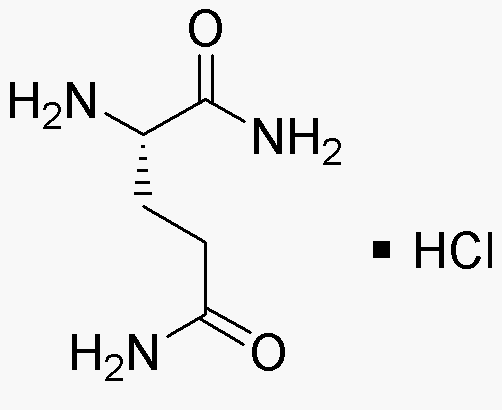L-Glutamine a-amide hydrochloride is widely utilized in research focused on:
- Nutrition and Dietary Supplements: Commonly used in sports nutrition products to support muscle recovery and enhance performance, particularly for athletes and bodybuilders.
- Pharmaceuticals: Serves as a key ingredient in formulations designed to treat conditions like gastrointestinal disorders, where it helps maintain gut health and integrity.
- Cell Culture: Essential in cell culture media for supporting the growth and maintenance of various cell lines, particularly in biopharmaceutical production.
- Neuroprotection: Investigated for its potential role in protecting neurons in neurodegenerative diseases, providing a basis for developing therapeutic strategies.
- Wound Healing: Used in topical formulations to promote healing and tissue repair, making it beneficial in dermatology and cosmetic applications.
General Information
Properties
Safety and Regulations
Applications
L-Glutamine a-amide hydrochloride is widely utilized in research focused on:
- Nutrition and Dietary Supplements: Commonly used in sports nutrition products to support muscle recovery and enhance performance, particularly for athletes and bodybuilders.
- Pharmaceuticals: Serves as a key ingredient in formulations designed to treat conditions like gastrointestinal disorders, where it helps maintain gut health and integrity.
- Cell Culture: Essential in cell culture media for supporting the growth and maintenance of various cell lines, particularly in biopharmaceutical production.
- Neuroprotection: Investigated for its potential role in protecting neurons in neurodegenerative diseases, providing a basis for developing therapeutic strategies.
- Wound Healing: Used in topical formulations to promote healing and tissue repair, making it beneficial in dermatology and cosmetic applications.
Documents
Safety Data Sheets (SDS)
The SDS provides comprehensive safety information on handling, storage, and disposal of the product.
Product Specification (PS)
The PS provides a comprehensive breakdown of the product’s properties, including chemical composition, physical state, purity, and storage requirements. It also details acceptable quality ranges and the product's intended applications.
Certificates of Analysis (COA)
Search for Certificates of Analysis (COA) by entering the products Lot Number. Lot and Batch Numbers can be found on a product’s label following the words ‘Lot’ or ‘Batch’.
*Catalog Number
*Lot Number
Certificates Of Origin (COO)
This COO confirms the country where the product was manufactured, and also details the materials and components used in it and whether it is derived from natural, synthetic, or other specific sources. This certificate may be required for customs, trade, and regulatory compliance.
*Catalog Number
*Lot Number
Safety Data Sheets (SDS)
The SDS provides comprehensive safety information on handling, storage, and disposal of the product.
DownloadProduct Specification (PS)
The PS provides a comprehensive breakdown of the product’s properties, including chemical composition, physical state, purity, and storage requirements. It also details acceptable quality ranges and the product's intended applications.
DownloadCertificates of Analysis (COA)
Search for Certificates of Analysis (COA) by entering the products Lot Number. Lot and Batch Numbers can be found on a product’s label following the words ‘Lot’ or ‘Batch’.
*Catalog Number
*Lot Number
Certificates Of Origin (COO)
This COO confirms the country where the product was manufactured, and also details the materials and components used in it and whether it is derived from natural, synthetic, or other specific sources. This certificate may be required for customs, trade, and regulatory compliance.


